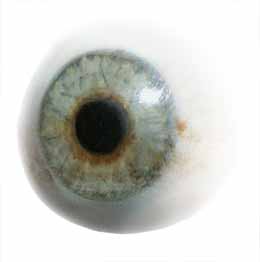[Question: Why is a paper about artificial eye EYEBALL paints published in the the journal of Brazilian ORAL Research? See below for the answer.]
If you’re an ocularist who creates bespoke hand-painted artificial eyes, presumably durability will be a prime concern. So, the question arises : Which kind of paint is best to colour-in the irises? There are several options available to you, for example: Hydrosoluble Gouache, Hydrosoluble Acrylic, Artist’s Oil Paint, or Nitrocellulose lacquer-based automotive paint. All four of which were examined for durability by a team of investigators from The School of Dentistry*, National University of Brasília, The Department of Dental* Materials and Prosthesis, School of Dentistry* of Araçatuba, São Paulo State University, and the School of Chemical Engineering of Lorena (FAENQUIL), Lorena, Brazil. Specially fabricated eye-like swatches were coated with the four paints (in both blue and brown) and then exposed to an accelerated ageing process using exaggerated humidity levels, accompanied by strong UV light. The conclusions: [artists’ oil paint wins]
• Hydrosoluble acrylic, hydrosoluble gouache, nitrocellulose-based automotive and oil paints present numerical chromatic alteration when submitted to accelerated aging by ultraviolet radiation and water condensation.
• The brown color presented statistically significant higher chromatic stability when compared with the blue color, irrespective of the paint and period of aging assessed.
• The oil paint has excellent and significant chromatic stability for use in painting artificial irises for prosthetic eyes polymerized by microwave
energy, irrespective of color, when compared with the other paints assessed.• Artificial eyes fabricated with dark pigments have a longer lifetime use.
See: Color alteration of the paint used for iris painting in ocular prostheses Brazilian Oral Research, vol.23, no.4, Oct./Dec., 2009.
*Note: Explaining, perhaps, why the paper was published in the journal of Brazilian Oral Research.
Also see: Artificial eyes, a look back
